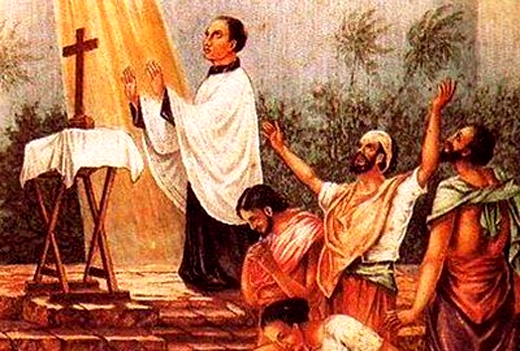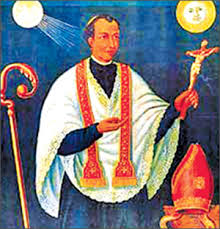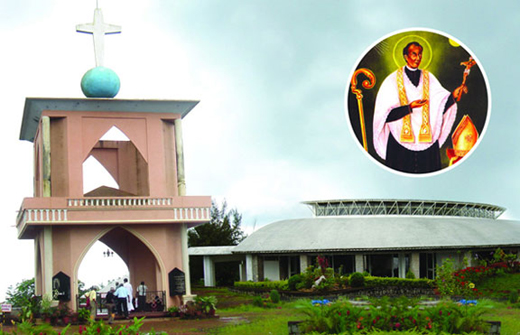Pope to Canonize Blessed Joseph Vaz early next 2015
Pope to Canonize Blessed Joseph Vaz early next 2015
Mangalore Today News Network
Vatican City, Sep 22, 2014: Blessed Joseph Vaz, the Goan missionary who preached in Sri Lanka, is expected to be canonized during the papal visit of the island nation early next year, says Bishop Vianney Fernando of Kandy.
"What would you say if a wish comes true after 300 years? The whole Church in Sri Lanka rejoices today," Bishop Fernando told Vatican’s Fides Agency yesterday.

"We have worked hard and overcome so many obstacles," he said. "Now we are simply happy. We hope and pray that the celebration will take place during the Pope’s visit to Sri Lanka. Our joy would be even doubled," he added.
Pope Francis on September 17, advanced the move to canonize Blessed Joseph Vaz, by approving a vote in favor of the canonization. This effectively waves off the requirement for a second miracle. Normally, two miracles attributed to a Blessed are considered a precondition for canonization.
Blessed Joseph Vaz (1651-1711), a native of Goa, worked for the evangelization of people in Sri Lanka when Catholics faced persecution during the Dutch occupation.
He founded more than 15 churches and 400 chapels in Sri Lanka and translated of the Gospel in the two languages of the country: Tamils and Sinhalese.
He was ordained a priest in the Congregation of St. Filippo Neri. His 23 years of work made his later known as the "Apostle of Sri Lanka".
The saintly priest died in Kandy in 1711, on January 16, the day on which his feast is celebrated in the liturgical calendar.
Pope John Paul II beatified him on January 21, 1995, during his visit to Sri Lanka.
His Holiness the pope has approved the votes in favour of the Ordinary Session of the Cardinals and Bishops about the canonization of Blessed Joseph Vaz, a priest of the Oratory of St. Philip Neri, founder of the oratory of the Holy Cross of Miracles in the city of Goa; born in Benaulin (India) on 21st April 1651 and died in Kandy (Sri Lanka), on 16th January 1711. His Holiness has finally decided to convene soon a consistory for the canonization of Blessed Joseph Vaz.
Most probably the canonization will take place at the Papal mass at the Galle Face green (Colombo, Sri Lanka) on the 14th January 2015. Let us thank God for the gift of Fr. Joseph Vaz, the Apostle of Sri Lanka.
History: Early life The third of six children, Vaz was born in 1651 at Benaulim, his mother’s village. His parents, Cristóvão Vaz and Maria de Miranda, were devout Catholics. Cristóvão belonged to a prominent Goud Saraswat Brahmin Naik family of Sancoale. He was baptised on the eighth day at the Parish Church of St. John the Baptist, Benaulim by its pastor, Jacinto Pereira. Vaz attended the elementary school in Sancoale. He learned Portuguese in Sancoale and Latin in Benaulim. He was a bright pupil and respected by his teachers and fellow students. He made such rapid progress in his studies that his father decided to send him to the city of Goa for further studies; where he did a course in rhetoric and Humanities at the Jesuit college of St. Paul. He further studied philosophy and theology at the College of St. Thomas Aquinas in Goa City.
The third of six children, Vaz was born in 1651 at Benaulim, his mother’s village. His parents, Cristóvão Vaz and Maria de Miranda, were devout Catholics. Cristóvão belonged to a prominent Goud Saraswat Brahmin Naik family of Sancoale. He was baptised on the eighth day at the Parish Church of St. John the Baptist, Benaulim by its pastor, Jacinto Pereira. Vaz attended the elementary school in Sancoale. He learned Portuguese in Sancoale and Latin in Benaulim. He was a bright pupil and respected by his teachers and fellow students. He made such rapid progress in his studies that his father decided to send him to the city of Goa for further studies; where he did a course in rhetoric and Humanities at the Jesuit college of St. Paul. He further studied philosophy and theology at the College of St. Thomas Aquinas in Goa City.
In 1675, Vaz was ordained a deacon for the Archdiocese of Goa by Custódio de Pinho, the Vicar Apostolic of Bijapur and Golconda. In 1676, he was ordained a priest by the Archbishop of Goa, António Brandão, S.O.Cist. Soon after his ordination, he started going barefoot to live like the poor and acquired a reputation as a popular preacher and confessor. He opened a Latin school in Sancoale for prospective seminarians. In 1677 he consecrated himself as a "slave of Mary", sealing it with a document known as the "Deed of Bondage".
Ministry in Canara/Mangalore (1681–1687)
Vaz wanted to serve as a missionary in Ceylon, and therefore presented his request to go there to the cathedral chapter, which was administering the diocese following the vacancy created by the death of Brandão on 6 July 1678. However, the cathedral chapter proposed to him to go to Canara instead, where the Padroado authorities in Goa were in conflict with the local authorities belonging to the Propaganda Fide. Vaz was appointed the Vicar Forane of Canara by the Padroado in 1681, and sent with the purpose of asserting their jurisdiction against the Propaganda Fide.[4] The chapter also gave him the esteemed title of "Frame of Canara".[1] Upon his arrival, he found the situation of the Roman Catholic Church there to be highly explosive.
The Padroado authorities in Goa were at conflict with those of the Propaganda Fide in Canara, led by the already incumbent Vicar Forane, Bishop Thomas de Castro. The source of the conflict was that De Castro’s appointment as Vicar Forane of Canara by Pope Clement X on 30 August 1675 was not recognised by the preceding Padroado archbishop. Consequently, they did not cede the jurisdiction to him despite the pope’s letter of appointment.
The Padroado–Propaganda conflict which ensued divided the Catholics of Canara into two sides—those who recognised the authority of the Padroado archbishop in Goa versus those who supported De Castro.[4] Those who recognised the authority of the Padroado were excommunicated by De Castro, while those who recognised the authority of the Propaganda were excommunicated by the Padroado authorities at Goa. Both groups were forbidden from receiving sacraments from the priests of the rival group, on penalty of excommunication.
With great diplomacy and humility, Vaz met De Castro at Mangalore and after having convinced himself of the legitimacy of the documents, brought about a truce until a direction was received from the new pope, Innocent XI. In light of the fact that the bishop had legitimate authority, Vaz recognised his authority and while continuing to adhere to the Padroado system, zealously worked for the religious welfare of the people. The bishop further agreed to delegate jurisdiction to him conditionally. Vaz often spoke to him and pleaded with him not to issue so many excommunications, but to wait for a final decision from the pope. He pointed out that the Hindus were scandalised and the Christians bewildered by these arguments.[1]
During his stay, Vaz undertook serious missionary activities in Canara from 1681 to 1684, carrying out a lot of missionary work in Mangalore, Basroor, Barcoor, Moolki,Kallianpur and other areas, and reviving the spirits and faith of the widely scattered Roman Catholic community.He reconstructed the Rosario Cathedral in Mangalore and built new churches at Onore, Basroor, Cundapore, and Gangolim.He also set up small schools in some of the villages with the co-operation of their residents.
Vaz’s most important contribution, however, was the establishment of a large number of Irmidades (Confraternities) throughout Canara, where he would periodically celebrate festive occasions with great pomp. Vaz was compelled to do so due to a shortage of priests, and as such an Irmidade brought together the Catholics of a place where there was no church or resident priest.[1] To this end, he constructed small huts and asked the local Catholics to gather there and recite their prayers. This greatly helped to keep alive and encourage the religious fervor for Christianity.
In his short stay, Vaz acquired a great and saintly reputation. He did yeoman service to the cause of the upliftment of the downtrodden. Many miracles are attributed to him. A local legend has it that while serving as parish priest of Our Lady of Mercy parish, Paneer, a few kilometres from Mudipu, Bantwal, a few Hindus arrived in the night, asking him to accompany them to administer final sacraments to a sick parishioner in the neighbourhood of Mudipu.
The men had conspired to slay the priest, due to his tireless missionary activities. When they reached the top of the Hill, the men tried to kill him. The serene Vaz knelt down on the rock and held his stick straight on the ground. A light flashed in their midst and the men could see water gushing from the spots where he knelt. Owing to this miracle, the men fled from the scene and Vaz returned to the parish unharmed. A shrine dedicated to him was constructed at that very site at Mudipu. It is visited annually by thousands of pilgrims and devotees, seeking blessings and cures for various ailments.
The new archbishop, Manuel de Sousa e Menezes, arrived in Goa and was displeased with Vaz on account of the agreement he had made with De Castro. When Vaz sought permission to return to Goa, the request was refused by the archbishop. After the archbishop’s death in 1684, however, the cathedral chapter of Goa allowed him to return to Goa, replacing him with Nicholas de Gamhoa, one of his former assistants.
THE PRESENT SCENARIO IN MANGALORE:
Mudipu which is about 8 km from Fajir Church is in between and borders Fajir, Ammembal and Vorkady parishes. Mudipu is an extensive village out of the 19 wards of Fajir Parish, 4 wards come under Mudipu Chapel. They are Pandikatta, Yermatti, Arkan and Kurnad. There are about a hundred families coming under these 4 wards.

Besides there are 25 families of Ammembal and Vorkady, who are living closer to Mudipu Chapel and later joined to Mudipu Parish made into Ira, Church, Sunangala and Kanthoor Kutatajje wards. Earlier Mudipu was a part of Panir Parish which was known as Pandikatta. Now it is divided into 4 wards. There is a hill in Mudipu which also belonged to Panir Parish. In 14.9.1937 the Pandikatta ward of Panir Parish was handed over to Fajir Parish together with the hill, the later as a donation.
Mudipu hill is a place of great importance which has a special history behind it. Rev.Fr. Joseph Vaz, born in Goa in the year 1651, April 21, worked in the Diocese of Mangalore from the year 1681 to 1684 and reached Mudipu preaching the Good News. He went house to house teaching catechism and serving the poor and the marginalized. This brought great joy to the people and was eagerly looking forward to his coming. But some people were against him and were trying to destroy him and his work. The place where they tried to harm him and kill him for his faith is marked even today upon the hill at Mudipu. Even today the faithful visit this place with great reverence and devotion. Later Fr. Joseph Vaz went to Sri Lanka and died there. For his virtues and the kind of life he led, he was made venerable in 1989 and now the “Blessed” in 1995. There is no doubt that very soon he will be canonized a saint and given the honor of the Altar and that day will be a great day for the people of Mudipu.
- India’s Court Backlogs Keep Drug Lords On The Streets
- Rethinking Drug Seizure Coverage: A Call for Health-Centred Narratives
- Substance abuse - A pressing concern among medical students
- China is winning the trade war without fighting
- Poll promises can become political nightmares
- While India sticks to death by hanging other execution methods vary across the world
- Spiking of drinks, a grave threat for students’ security
- Burden of drugs and substance use among university students in India
- Mangalore medic’s miracle in Bombay 1957
- Needed a national protocol for treatment of substance use disorders
- The Lingering Menace of Drug Abuse Among the Indian Youth—It’s Time for Action
- Need For ‘Students, Alcohol and Drugs’ survey
- New Synthetic Drugs Trapping Youth
- Kashmir Bhavan in Bengaluru: A must visit place
- "MAI and I" Book of Angelic Emotions
- Draupadi Murmu - The New ’President of India’
- Anthony Ashram in the city grows a classic museum
- First College of Fisheries in India - A Golden Jubilarian
- Flushing Meadows - A Vintage Mansion
- The Colonel�s Bequest
- A Mangalorean PM and his RBI Governor Brother: The Extraordinary story of the Benegal Brothers
- There is no higher religion than Truth: Theosophical Society
- L�affaire - Ashu & Yiju of Mangalore
- Mangalore in Kowloon
- 1568 to 2018 AD: 450 years of Christianity in Mangaluru
- Vice President elect Naidu moves on from nadir to zenith, the phenomenal journey
- Embracing the Outdoors: How Heated Jackets Are Revolutionizing Cold Weather Activities
- Efficient and Sustainable Packaging Solutions with FIBCs
- The Hybrid Kilt Revolution | Where Tradition Gets Trendy
- Affordable Elegance | Embrace Style on a Budget with Cheap Kilts
- Unleashing Style and Functionality | Exploring Tactical Kilts
- Mangalore’s Heroic Lady marks 105th Birthday
- Santa the Christmas spirit
- Geriatric care: Mangalore strikes a fine balance
- The Don Who Made Two Empires to Clash
- CHITRAPUR SARASWATS - A Great Kanara Community
- Our new President Ram Nath Kovind’s significant journey to Rashtrapathi Bhavan
- Marriages made in heaven, big fat weddings made in India
- Eid insight - The giver of glad tidings
- CITY INFORMATION
- TRAVEL
- TOURIST INFORMATION
- HEALTH CARE
- MISCELLANEOUS




 Write Comment
Write Comment E-Mail To a Friend
E-Mail To a Friend Facebook
Facebook Twitter
Twitter  Print
Print 

